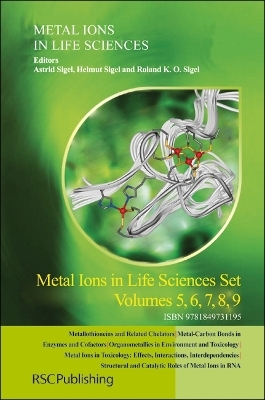
Metal Ions in Life Sciences Set
Royal Society of Chemistry (Verlag)
978-1-84973-119-5 (ISBN)
- Titel ist leider vergriffen;
keine Neuauflage - Artikel merken
Metallothioneins and Related Chelators Volume 5 These sulfur-rich chelators, being important in metal ion homeostasis, find increasing attention. MILS-5, written by 30 internationally recognized experts, focuses on this hot topic. The reader is supported by about 20 tables, more than 80 illustrations, and nearly 2000 references. This book is an essential resource for scientists working in the wide range from environmental toxicology and inorganic biochemistry all the way through to physiology and medicine. Metal-Carbon Bonds in Enzymes and Cofactors Volume 6 The occurrence of a wide variety of metal-carbon bonds in living organisms, ranging from bacteria to humans, is only recently appreciated. Of course, the historical examples are the B12 coenzymes containing cobalt-carbon bonds, but now such bonds are also known for nickel, iron, copper, and other transition metal ions. There is no other comparable book; MILS-6, written by 20 experts, summarizes the most recent insights into this fascinating topic. Metal-Carbon Bonds in Enzymes and Cofactors Volume 7 This volume, closely related to MILS-6, deals mainly with metal(loid)-alkyl derivatives but also with the rarer aryl compounds. Many of these (commonly toxic) compounds are formed in the environment by microorganisms, but some anthropogenic input occurs as well. MILS-7, with more than 2500 references, 35 tables, and nearly 50 illustrations, is of special relevance for researchers in analytical and bioinorganic chemistry, enzymology, environmental chemistry, physiology, toxicology, and related medical fields. Metal Ions in Toxicology: Effects, Interactions, Interdependencies Volume 8 MILS-8 deals with the risk assessment of toxic metal ions and their interdependencies focusing on humans and their organs; thus it carries on the topic of MILS-7 that centered on the environment. This book is of special relevance for researchers in toxicology, enzymology, health and safety institutions, those dealing with industrial safety regulations, and also for analytical, bioinorganic, and environmental chemists. Structural and Catalytic Roles of Metal Ions in RNA Volume 9 The discovery of ribozymes triggered a huge interest in the chemistry and biology of RNAs. Much of the recently made progress focusing on metal ions is addressed in MILS-9 ... it provides a most up-to-date view and is thus of special relevance for colleagues teaching biological inorganic chemistry and researchers dealing, e.g., with nucleic acids, gene expression, and enzymology, but also for those in analytical and bioinorganic chemistry or biophysics.
Astrid Sigel has studied languages and was an editor of the Metal Ions in Biological Systems series (until Volume 44) and also of the Handbooks on Toxicity of Inorganic Compounds (1988), on Metals in Clinical and Analytical Chemistry (1994; both with H. G. Seiler) and on Metalloproteins (2001; with Ivano Bertini). Helmut Sigel is Emeritus Professor (2003) of Inorganic Chemistry at the University of Basel, Switzerland, and a previous editor of the MIBS series until Volume 44. He serves on various editorial and advisory boards, published over 300 articles on metal ion complexes of nucleotides, coenzymes, and other ligands of biological relevance, and lectured worldwide. He was named Protagonist in Chemistry (2002) by ICA (issue 339); among further honors are the P. Ray Award (Indian Chemical Society, of which he is also an Honorary Fellow), the Werner Award (Swiss Chemical Society), a Doctor of Science honoris causa degree (Kalyani University, India), appointments as Visiting Professor (e.g., Austria, China, Japan, UK) and Endowed Lectureships. Roland K. O. Sigel is Associate Professor (2009) of Inorganic Chemistry at the University of Zurich, Switzerland,; from 2003 to 2008 he was endowed with a Förderungsprofessur of the Swiss National Science Foundation. He received his doctoral degree summa cum laude (1999) from the University of Dortmund, Germany, working with Bernhard Lippert. Thereafter he spent nearly three years at Columbia University, New York, USA, with Anna Marie Pyle (now Yale University). During the six years abroad he received several prestigeous fellowships from various sources, and he was awarded the EuroBIC Medal in 2008. His research focuses on the structural and catalytic role of metal ions in ribozymes, especially group II introns, and on related topics. He was also an editor of Volumes 43 and 44 of the MIBS series.
| Erscheint lt. Verlag | 31.3.2011 |
|---|---|
| Reihe/Serie | Metal Ions in Life Sciences |
| Zusatzinfo | Not illustrated |
| Verlagsort | Cambridge |
| Sprache | englisch |
| Maße | 156 x 234 mm |
| Themenwelt | Studium ► 2. Studienabschnitt (Klinik) ► Pharmakologie / Toxikologie |
| Naturwissenschaften ► Biologie ► Biochemie | |
| Naturwissenschaften ► Chemie | |
| ISBN-10 | 1-84973-119-5 / 1849731195 |
| ISBN-13 | 978-1-84973-119-5 / 9781849731195 |
| Zustand | Neuware |
| Haben Sie eine Frage zum Produkt? |
aus dem Bereich


